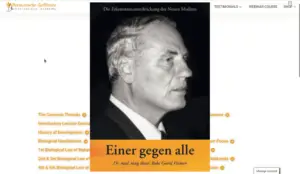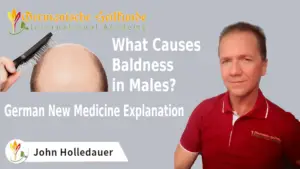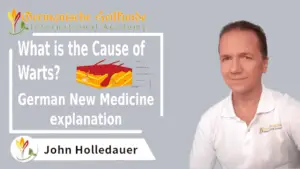
Hay fever is always only the track that points to the original conflict. If one finds the SBS, one usually recognizes that the conflict has been meaningless for a long time. Lifelong allergies often heal spontaneously when the knot is loosened by recognizing it.
After watching this video, you’ll understand why.
When we talk about hay fever we are focusing on the nasal mucosa, the squamous mucosa, which is the red group. The conflict content for the nasal mucosa is called stink conflict or scent conflict. But what does this scent conflict have to do with hay?
Hay is only the track, which causes recurrences . The SBS of the nasal mucosa reoccurs over and over again.
So hay must have played a role in this biological and scent conflict.
The brain stores in the track, the hay, the ability to react on time in the future against the cause or in other words against the scent conflict.
As I said, Mother Nature does nothing evil but always something sensible. The sensible thing with this SBS lies in the conflict-active phase to achieve a function enhancement by cell loss.
The nasal mucosa ulcerates away, making the lumen of the nose larger to be able to sense the danger better or to sense it earlier. In this example, with the hay allergy, the brain warns the individual to “watch out!” With this conflict, hay has played a role and the brain warns that it could happen again!
So the hay allergy sufferer has suffered a scent conflict in the hay! Since then, he has reacted allergically to hay with his nasal mucosa.
A 40 year old farmer has had a brutal hey allergy since he was five. As a farmer, he spends a lot of time in the open air and suffers terribly from it. That is why he started to study the Germanische Heilkunde of Dr. Hamer. The farmer explained that he knew exactly how it all started when he was five years old.
He spent half an afternoon rolling down a steep meadow hill with his 7-year-old sister. Suddenly he stood up, and his face was entirely swollen. Since then, he has had this allergy to hay.
He knows how it all started, but his allergy doesn’t change.
A study circle leader, who heard the story, said to him: Your sister must have pushed you!
Instantly on hearing this additional information the farmer’s hay fever disappeared and has never returned.
What happened here?
You can learn something from every testimonial!
The forty-year-old man could remember everything, but he repressed the conflict!
Repression plays a significant role in our psyche! We are able to transform conflicts into something liveable by repressing them. Repression is quite sensible!
Repression makes us unable to remember a conflict no matter how hard we try. And this makes finding the conflict even more difficult.
One phenomenon here is that the worse the conflict, the stronger the repression. In our Case Study, the farmer could remember everything except for the fact that his sister pushed him.
He only has this one sister, and he loves her adorably to this day. That’s why it was so bad for him!
My beloved sister did such a bad thing and pushed me down the slope! He has suppressed this aspect of his conflict. In that push of his sister down the hill, he suffered the conflict:
What happens now? Highly acutely dramatic, isolative perceived, and caught on the wrong foot.
Put yourself in the boy’s place at the moment of conflict. You need some empathy to do that, of course. And in this fall down the hill, his brain stored the grass with it.
But why did his hay allergy vanish into thin air?
The track is part of the conflict and is stored photographically as with a camera with the Dirk Hamer Syndrome (DHS) – that is, at the moment when the Hamer focus arises in the brain and visibly changes the brain. The track is part of the conflict. The track is nothing evil but a kind of early warning system, similar to a radar system and reminds the farmer to “watch out, back at the hay, this bad thing happened. Watch out!”
The body instantly switches over to the special program! And because the track belongs to the conflict, thus to the cause, the track works until the cause is solved.
When is a cause or a conflict solved? The conflict is resolved when it can’t happen anymore, when it doesn’t bother you or when you can laugh about it. The sister was older by two years. She was certainly stronger than him then. Today she is no longer! That means what happened then can’t happen today. Today the 40-year-old farmer would not let himself be pushed down the hill by his 42-year-old sister. 40-year-olds no longer let themselves be rolled down the hill, either. This conflict is irrelevant to him today. That is why his hay allergy disappeared.
This case study also shows how important it is to find your way precisely to the conflict, to find your way exactly into this moment. Only when one has grasped this moment of shock in its entirety can this Gordian knot in our brain be loosened. The farmer knew when his hay allergy started and why. He had merely repressed the worst of it. And it was the life experience of the study group leader who put one and one together and hit the nail on the head.
The blindfold fell from the 40-year-old’s eyes, and he was cured of his allergy.
With Germanische Heilkunde, neither doctor nor medicine stands between you and your health. No doctor can heal, and no medicine can cure!
So continue to study the Germanische Heilkunde.
Study the testimonials on the homepage. Try to put yourself in the position of the person concerned. You also study with it how we – how human beings – tick!
You will become human whisperers.
Have fun, and until the next video






| Cookie | Duration | Description |
|---|---|---|
| cookielawinfo-checkbox-analytics | 11 months | This cookie is set by GDPR Cookie Consent plugin. The cookie is used to store the user consent for the cookies in the category "Analytics". |
| cookielawinfo-checkbox-functional | 11 months | The cookie is set by GDPR cookie consent to record the user consent for the cookies in the category "Functional". |
| cookielawinfo-checkbox-necessary | 11 months | This cookie is set by GDPR Cookie Consent plugin. The cookies is used to store the user consent for the cookies in the category "Necessary". |
| cookielawinfo-checkbox-others | 11 months | This cookie is set by GDPR Cookie Consent plugin. The cookie is used to store the user consent for the cookies in the category "Other. |
| cookielawinfo-checkbox-performance | 11 months | This cookie is set by GDPR Cookie Consent plugin. The cookie is used to store the user consent for the cookies in the category "Performance". |
| viewed_cookie_policy | 11 months | The cookie is set by the GDPR Cookie Consent plugin and is used to store whether or not user has consented to the use of cookies. It does not store any personal data. |
You’ll be informed by email when we post new articles and novelties. In every email there is a link to modify or cancel your subscription.